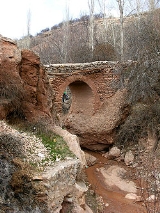
Zonouz
Encyclopedia
Zonuz is a city in the Central District
of Marand County
, East Azerbaijan Province, Iran
. At the 2006 census, its population was 2,618, in 826 families.
Zonuz is located on a mountain, and has very cold and snowy weather in winter and cool summers. The Zonuz valley is located between two mountain ranges, extending east to west. The mountain ranges are connected to each other in the east by Soltan Sanjar Mountain. The height of these mountains decreases from east to west. Soltan Sanjar has an altitude of 3,168 meters; other mountains namely,– Nevasar, Gerdehowul and Diragah – range from 2500 to 2200 meters in height.
to the Quaternary
period (the age of rocks is related to different geologic periods).
The Iranian
origins of the Azeris probably derive from ancient Iranian tribes (such as the Medes
in Iranian Azarbaijan
and Scythian invaders who arrived during the eighth century BCE). It is believed that the Medes mixed with the indigenous population, the Caucasian Mannai (a northeast Caucasian group related to the Urartians). Ancient written accounts, such as one written by Arab historian Abu al-Hasan Ali ibn al-Husayn al-Masudi(896-956), attest to an Iranian presence in the region: "The Persians are a people whose borders are the Mahat Mountains and Azarbaijan up to Armenia and Aran, and Bayleqan and Darband, and Ray and Tabaristan and Masqat and Shabaran and Jorjan and Abarshahr, and that is Nishabur, and Herat and Marv and other places in land of Khorasan, and Sejistan and Kerman and Fars and Ahvaz...All these lands were once one kingdom with one sovereign and one language...although the language differed slightly. The language, however, is one, in that its letters are written the same way and used the same way in composition. There are, then, different languages such as Pahlavi, Dari, Azari, as well as other Persian languages." A poem from Safina-yi Tabriz exists which is written in the old Iranian dialect of Azerbaijan.
Scholars see cultural similarities between modern Persians and Azeris as evidence of an ancient Iranian influence. Archaeological evidence indicates that the Iranian religion of Zoroastrianism
was prominent throughout the Caucasus before the advent of Christianity and Islam, and the influence of various Persian empires added to the Iranian character of the area. It has also been hypothesized that the population of Iranian Azarbaijan was predominantly Persian-speaking before the arrival of the Oghuz Turks
. This claim is supported by many ancient Persian literary figures (such as Qatran Tabrizi, Shams Tabrizi, Nezami, and Khaghani), who wrote in Persian prior to (and during) the Oghuz migration, as well as by Strabo, Al-Istakhri, and Al-Masudi, who all describe the language of the region as Persian. The claim is mentioned by other medieval historians, such as Al-Muqaddasi. Other common Perso-Azeribaijani features include Iranian place names such as Tabriz and the name "Azerbaijan" itself.
Sources such as the Encyclopaedia Iranica explain that "The Turkish speakers of Azerbaijan (q.v.) are mainly descended from the earlier Iranian speakers, several pockets of whom still exist in the region." The modern presence of the Iranian Talysh and Tats in Azerbaijan is further evidence of the former Iranian character of the region. As a precursor to these modern groups, the ancient Azaris are also hypothesized as ancestors of the modern Azerbaijanis.
The Encyclopædia Britannica refers to Azeris in the Republic of Azerbaijan: "The Azerbaijani are of mixed ethnic origin, the oldest element deriving from the indigenous population of eastern Transcaucasia and possibly from the Medians of northern Persia."
The Caucasian origin primarily applies to the Azeris of the Caucasus, most of whom are now inhabitants of the Republic of Azerbaijan. There is evidence that (despite repeated invasions and migrations) aboriginal Caucasians may have been culturally assimilated – first by the Iranians and later by the Oghuz. Considerable information has been learned about Caucasian Albania
ns (not to be confused with the Albanians of southest Europe) about their language, history, early conversion to Christianity and ties to the Armenians. Many academics believe that the Udi language
(still spoken in Azerbaijan) is a remnant of the Albanians' language.
This Caucasian influence extended further south into Iranian Azarbaijan. During the 1st millennium BCE, another Caucasian people, the Mannaeans
(Mannai), populated much of Iranian Azarbaijan. Weakened by conflicts with the Assyrians, the Mannaeans are believed to have been conquered and assimilated by the Medes
by 590 BCE.
, and people in the Azarbaijan region of Iran genetically resemble other Iran
ians.
language. The people of Zonouz today speak Azeri
, a primarily-Turkic
language with many Iranian remnants.
Thus, centuries of linguistic Turkification helped formulate the modern Azerbaijani language.
, most of the population of Iran became Sunni
Muslims. Currently the inhabitants of Zonouz (like most Iranians) are Shia Muslims, with some Zoroastrians and newly-converted Christians.
dynasty and the early Qajar dynasty.
At that time, in many Persian cities there was disorder, social unrest and insecurity resulting from the transition between the Zand and Qajar dynasties; Zonouz was no exception under the rule of Donbali Khavanin, during which there were many social and economic problems. Consequently, many residents left Zonouz for other cities; while the government apparently supported the people, the end result was poverty and slavery (a proverb states, "The butcher shows a bunch of grass to the sheep in order to direct the sheep toward the slaughterhouse"). As residents of Zonouz left their homes for opportunity elsewhere, Donbali Khavanin seized their lands with illegal documents (which were transferred to his successors Seyed Ali Mojtahed, Aziz Khan Donbali and Shoa al Saltaneh, uncle of Mozaffar al-Din Shah Qajar).
Shoa al Saltaneh oppressed the people of Zonouz, many of whom subsequently left for Russia
. His cruel behaviour caused him to be murdered in Tabriz
by a tailor's employee. Shoa al Saltaneh's successors sold the property document to Mortazavi. Mortazavi (who lived in Tabriz) was a powerful Azerbaijani landlord. Mortazavi selected local powerful men as agents for collecting rent based on farm products.
A large share of farmers' income were collected for him. Crops were divided between landowner and farmer; the base rent was one-third the yield from irrigated lands and one-fourth from dry land. Additionally there were collections of animal oil, butter, sheep, and cheese for the landlords, which oppressed Zonouz' farmers. "The poem of harvest which is written by Eftekhari about oppressed farmers of Zonouz is the best evidence". Land reform was undertaken by Mohammad Reza Pahlavi
in 1963, and the living conditions of farmers were improved with the end of feudalism
. During the Pahlavi period, the total ownership of Zonouz was 90 shares. Each farmer had to buy his own share from successors of Mortazavi (Abdolvah hab). By buying out the landlord, feudalism gradually disappeared from Zonouz society.
-Jolfa
road, Zonouz is known for its many varieties of apples. It is considered the apple capital of Iran; nearly 25 different types of apple trees grow in Zonouz – half of them unique to the village, including Girde Shirin and Baljeyi. Zonouz' economy is based on apple production; it supplies not only the Azerbaijan region, but all of Iran. Its climate, fertile soil and adequate water for irrigation have made the area ideally suited for apple-growing.
Apple trees which grow in Zonouz can be classified into two major groups – native and imported varieties. The main native varieties are:
Imported red and yellow Lobnani apples have become very popular, taking market share from the native varieties; annual production of Lebnani apples is 3000 tons (domestic consumption is about 75 tons). It is a tasty, sweet-smelling, good-sized fruit weighing 300-400 grams. Apple orchards are the chief agricultural activity, in some cases replacing existing apricot orchards. Aside from Lobnani and the native varieties noted above, other apple varieties include Alangheh, Ag Alma, Pir Alma, Marand Almasi, Asheg Alma, Moshki and others. At the end of September, the apples are picked and placed in cold storage (they require cool temperatures to keep for a long period). In addition, Zonouz also has a local fruit known as Malachi. Zonouz also has well-known mountains (such as Mahar) which are tourist attractions. Solta Sanjar Mountain, at 3100 meters height in eastern Zonouz, is popular with mountain climbers and a holy mountain for pilgrims.
of Azerbaijan
.

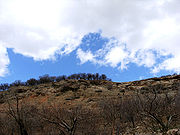
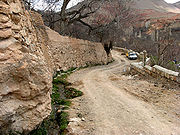
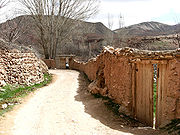
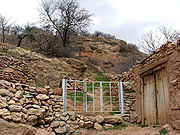
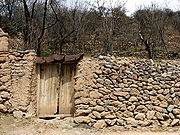
Central District (Marand County)
The Central District of Marand County is a district in Marand County, East Azerbaijan Province, Iran. At the 2006 census, its population was 201,747, in 52,369 families. The District has four cities: Marand, Zonuz, Koshksaray, and Bonab Jadid....
of Marand County
Marand County
Marand County is a county in East Azerbaijan Province in Iran. The capital of the county is Marand. At the 2006 census, the county's population was 229,215, in 59,097 families. The county is subdivided into two districts: the Central District and Yamchi District...
, East Azerbaijan Province, Iran
Iran
Iran , officially the Islamic Republic of Iran , is a country in Southern and Western Asia. The name "Iran" has been in use natively since the Sassanian era and came into use internationally in 1935, before which the country was known to the Western world as Persia...
. At the 2006 census, its population was 2,618, in 826 families.
Zonuz is located on a mountain, and has very cold and snowy weather in winter and cool summers. The Zonuz valley is located between two mountain ranges, extending east to west. The mountain ranges are connected to each other in the east by Soltan Sanjar Mountain. The height of these mountains decreases from east to west. Soltan Sanjar has an altitude of 3,168 meters; other mountains namely,– Nevasar, Gerdehowul and Diragah – range from 2500 to 2200 meters in height.
Topography
According to French geologist Hubet Rieben, Zonouz is formed by rocks from the DevonianDevonian
The Devonian is a geologic period and system of the Paleozoic Era spanning from the end of the Silurian Period, about 416.0 ± 2.8 Mya , to the beginning of the Carboniferous Period, about 359.2 ± 2.5 Mya...
to the Quaternary
Quaternary
The Quaternary Period is the most recent of the three periods of the Cenozoic Era in the geologic time scale of the ICS. It follows the Neogene Period, spanning 2.588 ± 0.005 million years ago to the present...
period (the age of rocks is related to different geologic periods).
- Calcareous rocks, a formation of the PaleozoicPaleozoicThe Paleozoic era is the earliest of three geologic eras of the Phanerozoic eon, spanning from roughly...
, date to the Devonian and form symmetrical layers. The color and hardness of these rocks differ. Calcareous layers are found on the north wall and eastern part of Diragah Mountain and are red and hard, although sometimes they may be light blue. On the southwest part of this mountain, olive-black calcareous layers may be distinguished. On the other hand, dark-brown and blue limestone is laid in the upper part of Zounuz's damDamA dam is a barrier that impounds water or underground streams. Dams generally serve the primary purpose of retaining water, while other structures such as floodgates or levees are used to manage or prevent water flow into specific land regions. Hydropower and pumped-storage hydroelectricity are...
. Here, the eruption of mineral springs through Calcareous rocks are seen. Unfortunately, the site has recently been submerged under water of dam. Different colors of limestone has been seen in the Zonouz area. On the high-altitude western slopes of Soltan Sanjar Mountain the limestone is dark red, whereas on the eastern slopes of Mount Zireh (in the northern part of Zonouz), black limestone may be seen. - Formations of the MesozoicMesozoicThe Mesozoic era is an interval of geological time from about 250 million years ago to about 65 million years ago. It is often referred to as the age of reptiles because reptiles, namely dinosaurs, were the dominant terrestrial and marine vertebrates of the time...
period are similar to those of the PaleozoicPaleozoicThe Paleozoic era is the earliest of three geologic eras of the Phanerozoic eon, spanning from roughly...
era. The limestone layers are hard. Some of them are covered with blue silicated limes; these are found in Safe-Ali, Navasar and some areas of Deravan Daghi. This type of limestone is also found in the western part of Soltan Sanjar. Some of the strata (such as conglomerate rock and rock salt) have risen to high elevations; therefore, travertineTravertineTravertine is a form of limestone deposited by mineral springs, especially hot springs. Travertine often has a fibrous or concentric appearance and exists in white, tan, and cream-colored varieties. It is formed by a process of rapid precipitation of calcium carbonate, often at the mouth of a hot...
rocks overlay them. Near Ramana, at the entrance to the Zonouz Road, the thickness of conglomerate rocks reaches 50 meters. From the third CenozoicCenozoicThe Cenozoic era is the current and most recent of the three Phanerozoic geological eras and covers the period from 65.5 mya to the present. The era began in the wake of the Cretaceous–Tertiary extinction event at the end of the Cretaceous that saw the demise of the last non-avian dinosaurs and...
period, strata of igneous rocks have been observed on the highlands of Soltan Sanjar Mountain (east of Diragah) and also on the east part of Oyukhly Mountain. Compared with other layers, they are mostly in a vertical shape. In the eastern part of Zonouz the landscape (of high walls of igneous rocks) extends about 4 kilometers to the east. This igneous rock wall rests on sandstone, salt-shale and gypsum formations. - QuaternaryQuaternaryThe Quaternary Period is the most recent of the three periods of the Cenozoic Era in the geologic time scale of the ICS. It follows the Neogene Period, spanning 2.588 ± 0.005 million years ago to the present...
period: In this period, horizontal travertine stones have lain on different formations of salt-shale. This quartzQuartzQuartz is the second-most-abundant mineral in the Earth's continental crust, after feldspar. It is made up of a continuous framework of SiO4 silicon–oxygen tetrahedra, with each oxygen being shared between two tetrahedra, giving an overall formula SiO2. There are many different varieties of quartz,...
travertine is found in eastern Zonouz (at an altitude of 1800–1900 meters), and also in the east of Zonouzag at an altitude of 2000 meters. Many springs emerge from these travertine stones – Kal-las-ser and Ali Suei springs, for example.
Demographics
- Race: AryanAryanAryan is an English language loanword derived from Sanskrit ārya and denoting variously*In scholarly usage:**Indo-Iranian languages *in dated usage:**the Indo-European languages more generally and their speakers...
- Branch: Iranian
- Ethnicity: Caucasian/Azeri or Iranian/Iranic / Iranian. In nearly all former Soviet states Azeri are still referred to as "Pers", which means "Persian" in Russian). The Caucasus has long been the centre of political debate for its geopolitical and natural resources, and imperial ambition has long played a role in the region. The ethnography of this region is considered Aryan, intermingled with some influence of migrating and occupation populations.
The Iranian
Iranian peoples
The Iranian peoples are an Indo-European ethnic-linguistic group, consisting of the speakers of Iranian languages, a major branch of the Indo-European language family, as such forming a branch of Indo-European-speaking peoples...
origins of the Azeris probably derive from ancient Iranian tribes (such as the Medes
Medes
The MedesThe Medes...
in Iranian Azarbaijan
Azerbaijan (Iran)
Azerbaijan or Azarbaijan , also Iranian Azerbaijan, Persian Azarbaijan is a region in northwestern Iran. It is also historically known as Atropatene and Aturpatakan....
and Scythian invaders who arrived during the eighth century BCE). It is believed that the Medes mixed with the indigenous population, the Caucasian Mannai (a northeast Caucasian group related to the Urartians). Ancient written accounts, such as one written by Arab historian Abu al-Hasan Ali ibn al-Husayn al-Masudi(896-956), attest to an Iranian presence in the region: "The Persians are a people whose borders are the Mahat Mountains and Azarbaijan up to Armenia and Aran, and Bayleqan and Darband, and Ray and Tabaristan and Masqat and Shabaran and Jorjan and Abarshahr, and that is Nishabur, and Herat and Marv and other places in land of Khorasan, and Sejistan and Kerman and Fars and Ahvaz...All these lands were once one kingdom with one sovereign and one language...although the language differed slightly. The language, however, is one, in that its letters are written the same way and used the same way in composition. There are, then, different languages such as Pahlavi, Dari, Azari, as well as other Persian languages." A poem from Safina-yi Tabriz exists which is written in the old Iranian dialect of Azerbaijan.
Scholars see cultural similarities between modern Persians and Azeris as evidence of an ancient Iranian influence. Archaeological evidence indicates that the Iranian religion of Zoroastrianism
Zoroastrianism
Zoroastrianism is a religion and philosophy based on the teachings of prophet Zoroaster and was formerly among the world's largest religions. It was probably founded some time before the 6th century BCE in Greater Iran.In Zoroastrianism, the Creator Ahura Mazda is all good, and no evil...
was prominent throughout the Caucasus before the advent of Christianity and Islam, and the influence of various Persian empires added to the Iranian character of the area. It has also been hypothesized that the population of Iranian Azarbaijan was predominantly Persian-speaking before the arrival of the Oghuz Turks
Oghuz Turks
The Turkomen also known as Oghuz Turks were a historical Turkic tribal confederation in Central Asia during the early medieval Turkic expansion....
. This claim is supported by many ancient Persian literary figures (such as Qatran Tabrizi, Shams Tabrizi, Nezami, and Khaghani), who wrote in Persian prior to (and during) the Oghuz migration, as well as by Strabo, Al-Istakhri, and Al-Masudi, who all describe the language of the region as Persian. The claim is mentioned by other medieval historians, such as Al-Muqaddasi. Other common Perso-Azeribaijani features include Iranian place names such as Tabriz and the name "Azerbaijan" itself.
Sources such as the Encyclopaedia Iranica explain that "The Turkish speakers of Azerbaijan (q.v.) are mainly descended from the earlier Iranian speakers, several pockets of whom still exist in the region." The modern presence of the Iranian Talysh and Tats in Azerbaijan is further evidence of the former Iranian character of the region. As a precursor to these modern groups, the ancient Azaris are also hypothesized as ancestors of the modern Azerbaijanis.
The Encyclopædia Britannica refers to Azeris in the Republic of Azerbaijan: "The Azerbaijani are of mixed ethnic origin, the oldest element deriving from the indigenous population of eastern Transcaucasia and possibly from the Medians of northern Persia."
The Caucasian origin primarily applies to the Azeris of the Caucasus, most of whom are now inhabitants of the Republic of Azerbaijan. There is evidence that (despite repeated invasions and migrations) aboriginal Caucasians may have been culturally assimilated – first by the Iranians and later by the Oghuz. Considerable information has been learned about Caucasian Albania
Caucasian Albania
Albania is a name for the historical region of the eastern Caucasus, that existed on the territory of present-day republic of...
ns (not to be confused with the Albanians of southest Europe) about their language, history, early conversion to Christianity and ties to the Armenians. Many academics believe that the Udi language
Udi language
The Udi language, spoken by the Udi people, is a member of the Lezgic branch of the Northeast Caucasian language family. It is believed an earlier form of it was the main language of Caucasian Albania, which stretched from south Dagestan to current day Azerbaijan.The language is spoken by about...
(still spoken in Azerbaijan) is a remnant of the Albanians' language.
This Caucasian influence extended further south into Iranian Azarbaijan. During the 1st millennium BCE, another Caucasian people, the Mannaeans
Mannaeans
The Mannaeans were an ancient people who lived in the territory of present-day Iran and Azerbaijan, around the 10th to 7th centuries BC...
(Mannai), populated much of Iranian Azarbaijan. Weakened by conflicts with the Assyrians, the Mannaeans are believed to have been conquered and assimilated by the Medes
Medes
The MedesThe Medes...
by 590 BCE.
Genetics
Genetic studies suggest that recent erosion of human population structure might not be as important as previously thought, and overall genetic structure of human populations may not change with immigration events such as those in Azerbaijan; the Azeris of Azerbaijan genetically resemble other Caucasian peoples like the ArmeniansArmenians
Armenian people or Armenians are a nation and ethnic group native to the Armenian Highland.The largest concentration is in Armenia having a nearly-homogeneous population with 97.9% or 3,145,354 being ethnic Armenian....
, and people in the Azarbaijan region of Iran genetically resemble other Iran
Iran
Iran , officially the Islamic Republic of Iran , is a country in Southern and Western Asia. The name "Iran" has been in use natively since the Sassanian era and came into use internationally in 1935, before which the country was known to the Western world as Persia...
ians.
Language
The original language of the people of Zonouz was Azari, an IranianIranian languages
The Iranian languages form a subfamily of the Indo-Iranian languages which in turn is a subgroup of Indo-European language family. They have been and are spoken by Iranian peoples....
language. The people of Zonouz today speak Azeri
Azerbaijani language
Azerbaijani or Azeri or Torki is a language belonging to the Turkic language family, spoken in southwestern Asia by the Azerbaijani people, primarily in Azerbaijan and northwestern Iran...
, a primarily-Turkic
Turkic languages
The Turkic languages constitute a language family of at least thirty five languages, spoken by Turkic peoples across a vast area from Eastern Europe and the Mediterranean to Siberia and Western China, and are considered to be part of the proposed Altaic language family.Turkic languages are spoken...
language with many Iranian remnants.
Thus, centuries of linguistic Turkification helped formulate the modern Azerbaijani language.
Religion
The inhabitants of Zonouz and Zonouzakh originally were Zoroastrians. After the attack by Arab invadersIslamic conquest of Persia
The Muslim conquest of Persia led to the end of the Sassanid Empire in 644, the fall of Sassanid dynasty in 651 and the eventual decline of the Zoroastrian religion in Persia...
, most of the population of Iran became Sunni
Sunni Islam
Sunni Islam is the largest branch of Islam. Sunni Muslims are referred to in Arabic as ʾAhl ūs-Sunnah wa āl-Ǧamāʿah or ʾAhl ūs-Sunnah for short; in English, they are known as Sunni Muslims, Sunnis or Sunnites....
Muslims. Currently the inhabitants of Zonouz (like most Iranians) are Shia Muslims, with some Zoroastrians and newly-converted Christians.
Ownership rights in Zonouz
The study of land ownership in Zonouz demonstrates many historical events and changes. In the History of Tabriz it is mentioned that Malek Mahmoud Tabrizi (son of Malek Mozaffar and a contemporary of Khajeh Rashid-al-din Fazlollah) lived during the Eilkhane-Moghol era. Malek Mahmoud Tabrizi sold Zonouz to Rashid-al-din Fazlollah. After his death, the ownership of Zonouz becomes unclear until the late ZandZand
Zand may refer to:* Zand tribe* the Lur Zand dynasty * Zand District, an administrative subdivision of Iran-See also:* Zend-Avesta or Zand-Avesta: the commentaries on primary sacred texts of Zoroastrianism...
dynasty and the early Qajar dynasty.
At that time, in many Persian cities there was disorder, social unrest and insecurity resulting from the transition between the Zand and Qajar dynasties; Zonouz was no exception under the rule of Donbali Khavanin, during which there were many social and economic problems. Consequently, many residents left Zonouz for other cities; while the government apparently supported the people, the end result was poverty and slavery (a proverb states, "The butcher shows a bunch of grass to the sheep in order to direct the sheep toward the slaughterhouse"). As residents of Zonouz left their homes for opportunity elsewhere, Donbali Khavanin seized their lands with illegal documents (which were transferred to his successors Seyed Ali Mojtahed, Aziz Khan Donbali and Shoa al Saltaneh, uncle of Mozaffar al-Din Shah Qajar).
Shoa al Saltaneh oppressed the people of Zonouz, many of whom subsequently left for Russia
Russia
Russia or , officially known as both Russia and the Russian Federation , is a country in northern Eurasia. It is a federal semi-presidential republic, comprising 83 federal subjects...
. His cruel behaviour caused him to be murdered in Tabriz
Tabriz
Tabriz is the fourth largest city and one of the historical capitals of Iran and the capital of East Azerbaijan Province. Situated at an altitude of 1,350 meters at the junction of the Quri River and Aji River, it was the second largest city in Iran until the late 1960s, one of its former...
by a tailor's employee. Shoa al Saltaneh's successors sold the property document to Mortazavi. Mortazavi (who lived in Tabriz) was a powerful Azerbaijani landlord. Mortazavi selected local powerful men as agents for collecting rent based on farm products.
A large share of farmers' income were collected for him. Crops were divided between landowner and farmer; the base rent was one-third the yield from irrigated lands and one-fourth from dry land. Additionally there were collections of animal oil, butter, sheep, and cheese for the landlords, which oppressed Zonouz' farmers. "The poem of harvest which is written by Eftekhari about oppressed farmers of Zonouz is the best evidence". Land reform was undertaken by Mohammad Reza Pahlavi
Mohammad Reza Pahlavi
Mohammad Rezā Shāh Pahlavi, Shah of Iran, Shah of Persia , ruled Iran from 16 September 1941 until his overthrow by the Iranian Revolution on 11 February 1979...
in 1963, and the living conditions of farmers were improved with the end of feudalism
Feudalism
Feudalism was a set of legal and military customs in medieval Europe that flourished between the 9th and 15th centuries, which, broadly defined, was a system for ordering society around relationships derived from the holding of land in exchange for service or labour.Although derived from the...
. During the Pahlavi period, the total ownership of Zonouz was 90 shares. Each farmer had to buy his own share from successors of Mortazavi (Abdolvah hab). By buying out the landlord, feudalism gradually disappeared from Zonouz society.
Agriculture
At the 20th kilometer of the MarandMarand
Marand is a city in and the capital of Marand County, East Azerbaijan Province, Iran. At the 2006 census, its population was 114,165, in 29,755 families....
-Jolfa
Jolfa
Jolfa is a city in and capital of Jolfa County, East Azerbaijan Province, Iran. At the 2006 census, its population was 4,983, in 1,365 families....
road, Zonouz is known for its many varieties of apples. It is considered the apple capital of Iran; nearly 25 different types of apple trees grow in Zonouz – half of them unique to the village, including Girde Shirin and Baljeyi. Zonouz' economy is based on apple production; it supplies not only the Azerbaijan region, but all of Iran. Its climate, fertile soil and adequate water for irrigation have made the area ideally suited for apple-growing.
Apple trees which grow in Zonouz can be classified into two major groups – native and imported varieties. The main native varieties are:
- Payeze: tasty, sweet-smelling, attractive color
- Gabala: round, tart, green/light-red color
- Torsh Alma: tart, perishable
- Baljeye: round, dark red , sweet-smelling, tasty (called "sweet honey")
- Gerdashirin: sweet, tasty summer apple
Imported red and yellow Lobnani apples have become very popular, taking market share from the native varieties; annual production of Lebnani apples is 3000 tons (domestic consumption is about 75 tons). It is a tasty, sweet-smelling, good-sized fruit weighing 300-400 grams. Apple orchards are the chief agricultural activity, in some cases replacing existing apricot orchards. Aside from Lobnani and the native varieties noted above, other apple varieties include Alangheh, Ag Alma, Pir Alma, Marand Almasi, Asheg Alma, Moshki and others. At the end of September, the apples are picked and placed in cold storage (they require cool temperatures to keep for a long period). In addition, Zonouz also has a local fruit known as Malachi. Zonouz also has well-known mountains (such as Mahar) which are tourist attractions. Solta Sanjar Mountain, at 3100 meters height in eastern Zonouz, is popular with mountain climbers and a holy mountain for pilgrims.
Zonouzaq (Zonouzakh)
Zonouzaq is a small village at the upper part of Zonouz. Famous for its architecture, it is known as the MasoulehMasouleh
Masuleh is a city in and the capital of Sardar-e Jangal District, in Fuman County, Gilan Province, Iran. At the 2006 census, its population was 554, in 180 families....
of Azerbaijan
Azerbaijan (Iran)
Azerbaijan or Azarbaijan , also Iranian Azerbaijan, Persian Azarbaijan is a region in northwestern Iran. It is also historically known as Atropatene and Aturpatakan....
.
External links
- more references
- Azapadegan Research Institute for Iranian cultures and civilization (includes research articles on Adhari)
- http://www.fallingrain.com/world/IR/1/Zonuz.html
- http://www.iranchamber.com/index.php
- http://www.tageo.com/index-e-ir-v-01-d-m4357019.htm
- http://www.iran-daily.com/1387/3272/html/iranica.htm
- erani.tk Lists of many similarities between some Iranian languages, in English and Turkish
- Society for Iranian Linguistics
- http://www.iranian-efl-journal.com Iranian EFL Journal
- Persian Language (Persian)
Further reading







